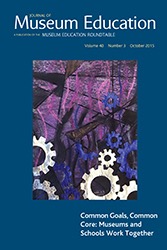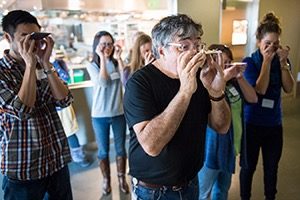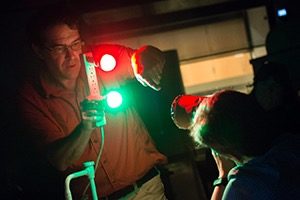Special Sauce
At MER, we love when an issue of the Journal of Museum Education (JME) lends its voice to a juicy conversation at the national level. And JME Vol. 40, No. 3, Common Goals, Common Core: Museums and Schools Work Together, did just that. The issue hit mailboxes in October, 2015. In November, 2015, Massachusetts opted to keep the Common Core State Standards (CCSS), but to develop its own state test rather than continue to participate in multi-state high-stakes testing. Massachusetts is not alone in its reinterpretation of the standards: the CCSS exists, in some form, in most states—but the form continues to shift. Meanwhile, museum educators must sort out their role in this evolving landscape (1).
 This issue piqued my interest because when I’m not moonlighting for the Museum Education Roundtable, I spend my days as the Program Manager for the Exploratorium Teacher Institute (TI). The Exploratorium is a museum of science, art, and human perception in San Francisco, CA. TI provides immersive hands-on professional development for middle and high school science teachers. As I read through the articles in Common Goals, Common Core, I saw a lot of parallels to today’s science teacher community.
This issue piqued my interest because when I’m not moonlighting for the Museum Education Roundtable, I spend my days as the Program Manager for the Exploratorium Teacher Institute (TI). The Exploratorium is a museum of science, art, and human perception in San Francisco, CA. TI provides immersive hands-on professional development for middle and high school science teachers. As I read through the articles in Common Goals, Common Core, I saw a lot of parallels to today’s science teacher community.
You see, as controversy continues to swirl around the CCSS, a complimentary set of standards has taken shape: the Next Generation Science Standards (NGSS). Similar to the CCSS, the NGSS was written to address college and career readiness, with a focus on skills and content knowledge in the fields of Science, Technology, Engineering, and Math (STEM). The Science & Engineering Practices and the Crosscutting Concepts outlined in the NGSS encourage students to gain a deeper understanding of the interconnectivity of scientific concepts and content, K-12. In other words, rote memorization, with little attention to context, will soon be a thing of the past in STEM classrooms (2).
While the CCSS may not have affected all of TI’s teachers, the Next Generation Science Standards (NGSS) absolutely will.
Shortly after the final draft of the NGSS was released in 2013, Brian J. Reiser, a professor of Learning Sciences in the School of Education and Social Policy at Northwestern University, argued that the following four statements need to be true for teacher professional development to be effective:
- Professional development should be embedded in subject matter
- Professional development needs to involve active learning
- Professional development needs to be connected to teachers’ own practice
- Professional development needs to be part of a coherent system of support (3)
From my perspective, it’s as though Reiser peeked through the window at a TI workshop at the Exploratorium, and listed off the ingredients he saw in our instructional ‘special sauce’. Let me explain.
1) Professional development should be embedded in subject matter.
We recently held a half-day workshop entitled “Conservation of Mass – It’s the Law! Or is it?”. Our instructors selected activities that related to the conservation of mass. They also identified a handful of NGSS Science & Engineering Practices that they wanted to engage in throughout the course of the workshop (e.g. developing and using models, planning and carrying out investigations, and engaging in argument from evidence). The Practices were thoughtfully interwoven with content. In other words: the teachers developed a working model for a conservation of mass activity that they then used in an experiment. Embedding the Practices in science content gave teachers a concrete understanding of both.

2) Professional development needs to involve active learning.
Teachers are engaged participants in our classroom. We do not hand teachers a suite of activities and send them back to their schools. Instead we take them through the messy, uncomfortable, thought-provoking, and exciting process of creating models, engaging in scientific debate, and designing (and re-designing) solutions. In doing so, our teachers get comfortable with the deeper level of inquiry and iteration (and time!) that will be required in their own classrooms.
3) Professional development needs to be connected to teachers’ own practice.
Teachers self-select to join our program. Professional development at the museum is (generally) not a district requirement. When teachers show up in our classroom it’s because they are intrinsically interested in deepening their content knowledge and their pedagogical practice.
4) Professional development needs to be part of a coherent system of support.
Professional development is spotty district-to-district, state-to-state. Museum professional development programming should strive to build an active “community of practice” among participants. These peer-to-peer relationships can go far in augmenting the professional development gaps that exist in today’s school system.
 While Reiser laid out these recommendations for Professional Development relating specifically to the NGSS, I would posit that they could be applied to any field with equal success. Teachers come to TI to learn new content, to sharpen pedagogical skills, to engage as students, and to connect with peers. Along the way, they gather tools that prepare them to reimagine their curriculum through the lens of a new set of standards.
While Reiser laid out these recommendations for Professional Development relating specifically to the NGSS, I would posit that they could be applied to any field with equal success. Teachers come to TI to learn new content, to sharpen pedagogical skills, to engage as students, and to connect with peers. Along the way, they gather tools that prepare them to reimagine their curriculum through the lens of a new set of standards.
Is your professional development programming hitting on all four cylinders? Are there other models that you might recommend?
Lexie Carlson is the Program Manager for the Teacher Institute (TI) at the Exploratorium in San Francisco, California. TI provides hands-on, inquiry-based, professional development for middle and high school science teachers. Lexie currently serves on the Board of the Museum Education Roundtable as a member of the Editorial Team.
Citations: (1) Massachusetts’s Rejection of Common Core Test Signals Shift in U.S. (2) NGSS: Frequently Asked Questions (3) What Professional Development Strategies Are Needed for Successful Implementation of the Next Generation Science Standards?
Opening photo credit: “G Love and Special Sauce(s)” by Janelle, via Flickr

